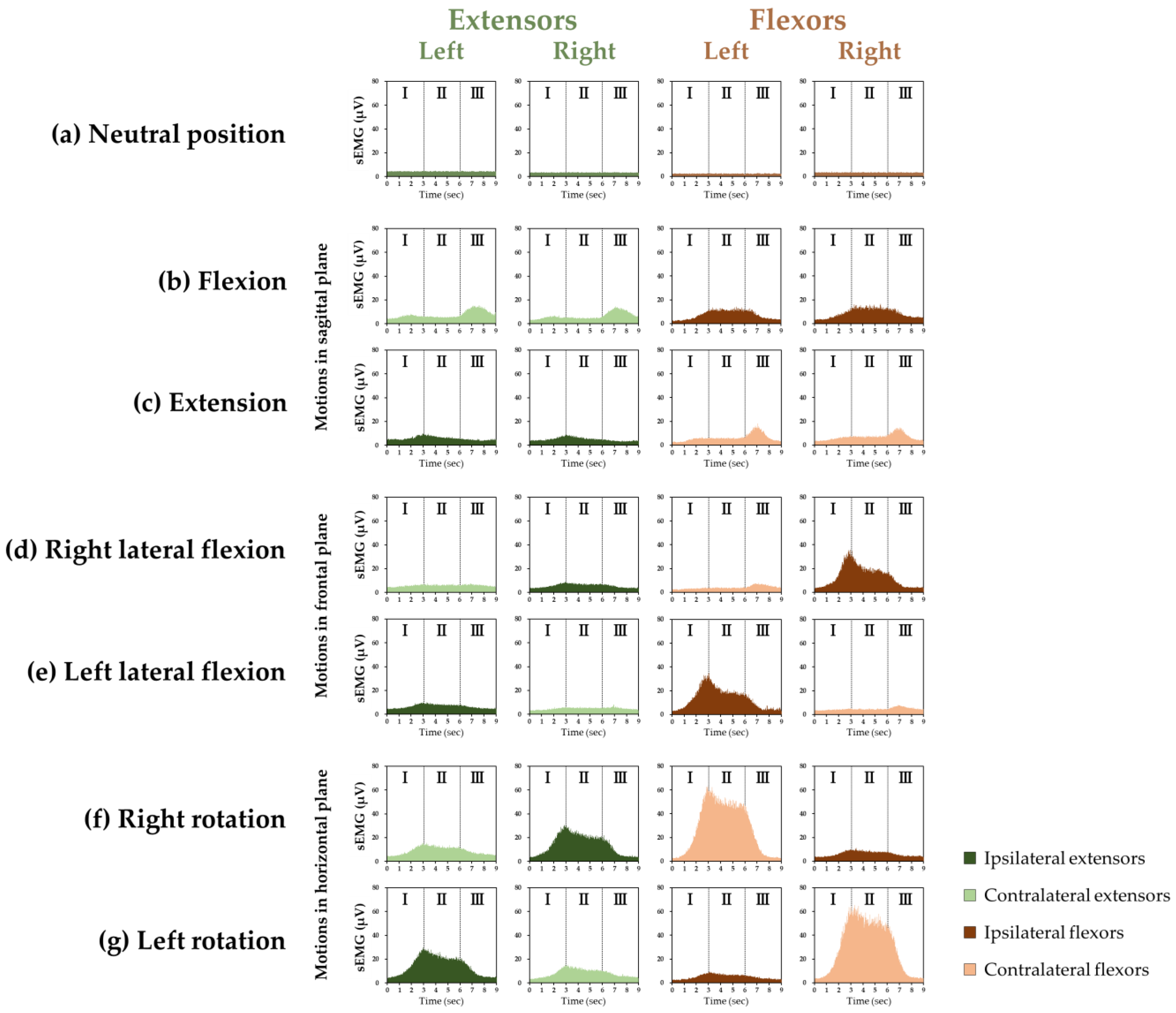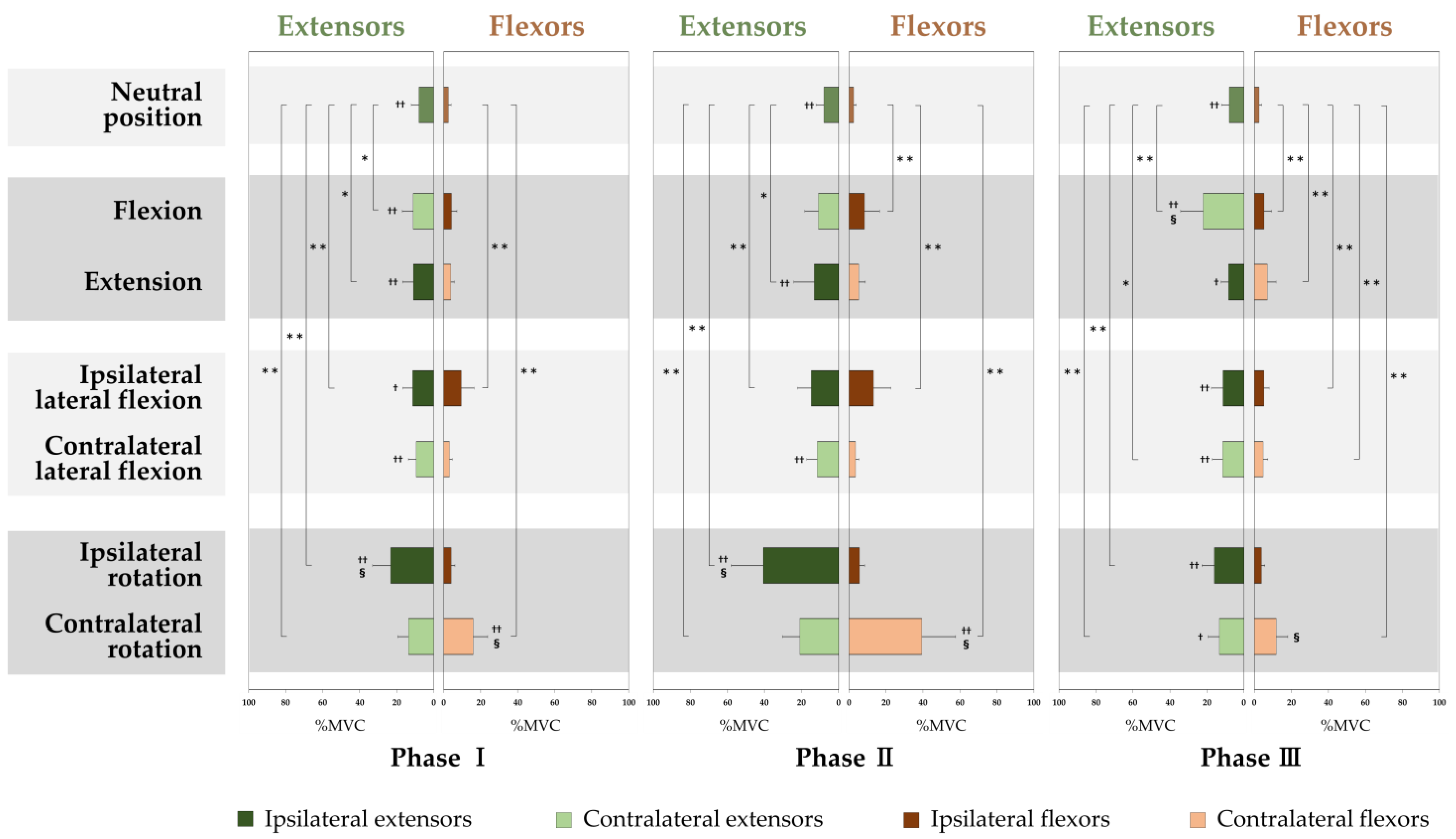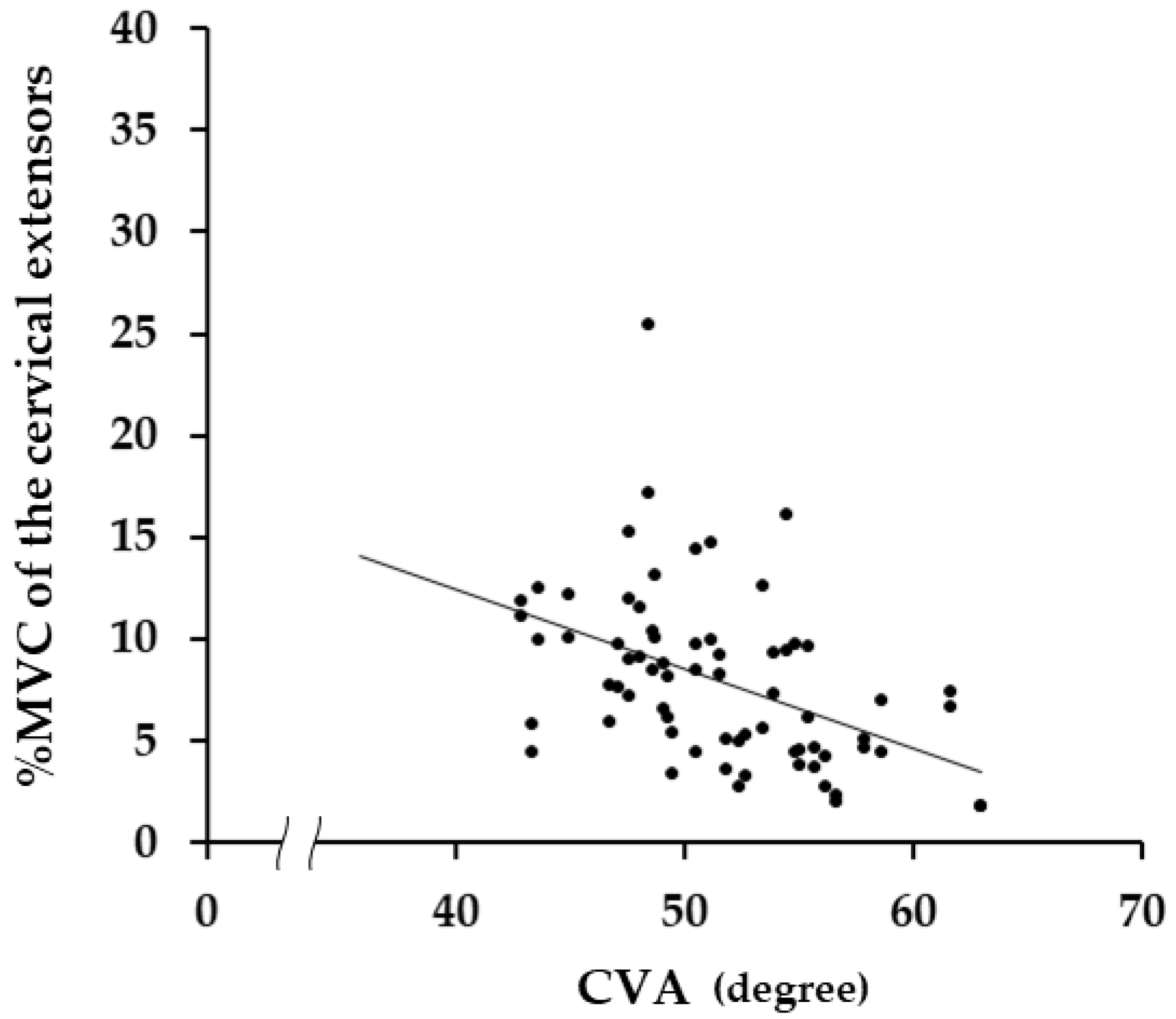The Mode of Activity of Cervical Extensors and Flexors in Healthy Adults: A Cross-Sectional Study
Abstract
1. Introduction
2. Methods
2.1. Participants
- Inclusion criteria: participants with no underlying diseases, no past or present pain in the neck, shoulders, or upper extremities, and no neurological symptoms such as numbness or hypoesthesia.
- Exclusion criteria: participants who were aware of pain in the neck, shoulders, and upper extremities, or had neurological symptoms such as numbness or hypoesthesia, or who suffered from diseases such as cervical disc herniation or rheumatoid arthritis.
2.2. Procedures for Recording Cervical Muscle Activity
2.2.1. Surface Electromyogram (sEMG)
2.2.2. Flow of sEMG Measurement
2.3. Assessment of Head and Neck Posture
2.4. Data Analysis
2.4.1. Grand Ensemble Average of sEMGs in Each Motion
2.4.2. A Percentage of Maximal Voluntary Contraction (%MVC) of Cervical Muscles
2.4.3. Craniovertebral Angle (CVA)
2.5. Statistical Analysis
3. Results
3.1. Activities in the Cervical Extensors and Flexors in the Neutral Position and Craniovertebral Angle (CVA)
3.2. Activities in the Cervical Extensors and Flexors in Each Motion Compared with the Neutral Position
3.3. Comparison of the Cervical Extensors and Flexors Activities in Each Motion
3.4. Comparison in Activities of the Cervical Extensors and Flexors Activities among the Motions
4. Discussion
4.1. Activities of the Cervical Muscles in Neutral Position
4.2. Cervical Muscle Activity in Each Motion Compared with the Neutral Position
4.3. Comparing the Activity of the Cervical Extensors and Flexors in Each Motion
4.4. Overall Interpretation of the Results
4.5. Limitations
5. Conclusions
- In the neutral position, the %MVC of the extensors was significantly larger than that of the flexors.
- In the motion from the neutral position to the maximum range of motion (Phase I), the %MVCs of the extensors in flexion and extension, the ipsilateral extensors and flexors in lateral flexion were significantly larger than the %MVC in the neutral position.
- At the maximum range of motion (Phase II), the %MVCs of the flexors in flexion, the extensors in extension, and the ipsilateral extensors and flexors in lateral flexion were significantly larger than the %MVC in the neutral position.
- In the motion from the maximum range of motion to the neutral position (Phase III), the %MVCs of the extensors and flexors in flexion, the flexors in extension, the bilateral flexors and the contralateral extensors in lateral flexion were significantly larger than the %MVC in the neutral position.
- In rotation, the %MVCs of the bilateral extensors and the contralateral flexors in all three phases were significantly larger than the %MVC in the neutral position.
Author Contributions
Funding
Institutional Review Board Statement
Informed Consent Statement
Data Availability Statement
Acknowledgments
Conflicts of Interest
References
- Hidalgo, B.; Hall, T.; Bossert, J.; Dugeny, A.; Cagnie, B.; Pitance, L. The efficacy of manual therapy and exercise for treating non-specific neck pain: A systematic review. J. Back Musculoskelet. Rehabil. 2017, 30, 1149–1169. [Google Scholar] [CrossRef] [PubMed]
- Price, J.; Rushton, A.; Tyros, I.; Heneghan, N.R. Effectiveness and optimal dosage of resistance training for chronic non-specific neck pain: A protocol for a systematic review with a qualitative synthesis and meta-analysis. BMJ Open 2019, 9, e025158. [Google Scholar] [CrossRef] [PubMed]
- Binder, A.I. Cervical spondylosis and neck pain. BMJ 2007, 334, 527–531. [Google Scholar] [CrossRef] [PubMed]
- Kumar, S.; Narayan, Y.; Amell, T.; Ferrari, R. Electromyography of superficial cervical muscles with exertion in the sagittal, coronal and oblique planes. Eur. Spine J. 2002, 11, 27–37. [Google Scholar] [CrossRef]
- Kumar, S.; Prasad, N. Cervical EMG profile differences between patients of neck pain and control. Disabil. Rehabil. 2010, 32, 2078–2087. [Google Scholar] [CrossRef]
- Haldeman, S.; Carroll, L.; Cassidy, J.D. Findings from the bone and joint decade 2000 to 2010 task force on neck pain and its associated disorders. J. Occup. Env. Med. 2010, 52, 424–427. [Google Scholar] [CrossRef]
- Hoy, D.; March, L.; Woolf, A.; Blyth, F.; Brooks, P.; Smith, E.; Vos, T.; Barendregt, J.; Blore, J.; Murray, C.; et al. The global burden of neck pain: Estimates from the global burden of disease 2010 study. Ann. Rheum. Dis. 2014, 73, 1309–1315. [Google Scholar] [CrossRef]
- Gfrerer, L.; Hansdorfer, M.A.; Ortiz, R.; Chartier, C.; Nealon, K.P.; Austen, W.G.; Haldeman, S.; Ammendolia, C.; Carragee, E.; Hurwitz, E.; et al. Muscle Fascia Changes in Patients with Occipital Neuralgia, Headache, or Migraine. Plast. Reconstr. Surg. 2021, 147, 176–180. [Google Scholar] [CrossRef]
- Strøm, V.; Røe, C.; Knardahl, S. Work-induced pain, trapezius blood flux, and muscle activity in workers with chronic shoulder and neck pain. Pain 2009, 144, 147–155. [Google Scholar] [CrossRef]
- Falla, D.; Bilenkij, G.; Jull, G. Patients with chronic neck pain demonstrate altered patterns of muscle activation during performance of a functional upper limb task. Spine 2004, 29, 1436–1440. [Google Scholar] [CrossRef]
- Yip, C.H.; Chiu, T.T.; Poon, A.T. The relationship between head posture and severity and disability of patients with neck pain. Man 2008, 13, 148–154. [Google Scholar] [CrossRef] [PubMed]
- Blanpied, P.R.; Gross, A.R.; Elliott, J.M.; Devaney, L.L.; Clewley, D.; Walton, D.M.; Sparks, C.; Robertson, E.K. Neck Pain: Revision 2017. J. Orthop. Sports Phys. 2017, 47, A1–A83. [Google Scholar] [CrossRef] [PubMed]
- McGill, S.M.; Grenier, S.; Kavcic, N.; Cholewicki, J. Coordination of muscle activity to assure stability of the lumbar spine. J. Electromyogr. Kinesiol. 2003, 13, 353–359. [Google Scholar] [CrossRef]
- Panjabi, M.M.; Cholewicki, J.; Nibu, K.; Grauer, J.; Babat, L.B.; Dvorak, J. Critical load of the human cervical spine: An in vitro experimental study. Clin. Biomech. 1998, 13, 11–17. [Google Scholar] [CrossRef]
- Dieterich, A.V.; Andrade, R.J.; Le Sant, G.; Falla, D.; Petzke, F.; Hug, F.; Nordez, A. Shear wave elastography reveals different degrees of passive and active stiffness of the neck extensor muscles. Eur. J. Appl. Physiol. 2017, 117, 171–178. [Google Scholar] [CrossRef]
- Hagberg, M. Occupational musculoskeletal stress and disorders of the neck and shoulder: A review of possible pathophysiology. Int. Arch. Occup. Env. Health 1984, 53, 269–278. [Google Scholar] [CrossRef]
- Watson, D.H.; Trott, P.H. Cervical headache: An investigation of natural head posture and upper cervical flexor muscle performance. Cephalalgia 1993, 13, 272–284. [Google Scholar] [CrossRef]
- Treleaven, J.; Jull, G.; Atkinson, L. Cervical musculoskeletal dysfunction in post-concussional headache. Cephalalgia 1994, 14, 273–279. [Google Scholar] [CrossRef]
- Barton, P.M.; Hayes, K.C. Neck flexor muscle strength, efficiency, and relaxation times in normal subjects and subjects with unilateral neck pain and headache. Arch. Phys. Med. Rehabil. 1996, 77, 680–687. [Google Scholar] [CrossRef]
- Placzek, J.D.; Pagett, B.T.; Roubal, P.J.; Jones, B.A.; McMichael, H.G.; Rozanski, E.A.; Gianotto, K.L. The influence of the cervical spine on chronic headache in women: A pilot study. J. Man Manip. 1999, 7, 33–39. [Google Scholar] [CrossRef]
- Falla, D. Unravelling the complexity of muscle impairment in chronic neck pain. Man 2004, 9, 125–133. [Google Scholar] [CrossRef] [PubMed]
- Kumar, S.; Narayan, Y.; Prasad, N.; Shuaib, A.; Siddiqi, Z.A. Cervical electromyogram profile differences between patients of neck pain and control. Spine 2007, 32, E246–E253. [Google Scholar] [CrossRef] [PubMed]
- Falla, D.L.; Jull, G.A.; Hodges, P.W. Patients with neck pain demonstrate reduced electromyographic activity of the deep cervical flexor muscles during performance of the craniocervical flexion test. Spine 2004, 29, 2108–2114. [Google Scholar] [CrossRef] [PubMed]
- Meyer, J.J.; Berk, R.J.; Anderson, A.V. Recruitment patterns in the cervical paraspinal muscles during cervical forward flexion: Evidence of cervical flexion-relaxation. Electromyogr Clin. Neurophysiol. 1993, 33, 217–223. [Google Scholar] [PubMed]
- Airaksinen, M.K.; Kankaanpää, M.; Aranko, O.; Leinonen, V.; Arokoski, J.P.; Airaksinen, O. Wireless on-line electromyography in recording neck muscle function: A pilot study. Pathophysiology 2005, 12, 303–306. [Google Scholar] [CrossRef]
- Murphy, B.A.; Marshall, P.W.; Taylor, H.H. The cervical flexion-relaxation ratio: Reproducibility and comparison between chronic neck pain patients and controls. Spine 2010, 35, 2103–2108. [Google Scholar] [CrossRef]
- Jull, G.; Kristjansson, E.; Dall’Alba, P. Impairment in the cervical flexors: A comparison of whiplash and insidious onset neck pain patients. Man 2004, 9, 89–94. [Google Scholar] [CrossRef]
- Johnston, V.; Jull, G.; Souvlis, T.; Jimmieson, N.L. Neck movement and muscle activity characteristics in female office workers with neck pain. Spine 2008, 33, 555–563. [Google Scholar] [CrossRef]
- Lecompte, J.; Maisetti, O.; Guillaume, A.; Portero, P. Agonist and antagonist EMG activity of neck muscles during maximal isometric flexion and extension at different positions in young healthy men and women. Isokinet. Exerc. Sci. 2009, 15, 29–36. [Google Scholar] [CrossRef]
- Benatto, M.T.; Florencio, L.L.; Bragatto, M.M.; Lodovichi, S.S.; Dach, F.; Bevilaqua-Grossi, D. Extensor/flexor ratio of neck muscle strength and electromyographic activity of individuals with migraine: A cross-sectional study. Eur. Spine J. 2019, 28, 2311–2318. [Google Scholar] [CrossRef]
- Choi, H. Quantitative assessment of co-contraction in cervical musculature. Med. Eng. Phys. 2003, 25, 133–140. [Google Scholar] [CrossRef]
- Burnett, A.; O’Sullivan, P.; Caneiro, J.P.; Krug, R.; Bochmann, F.; Helgestad, G.W. An examination of the flexion-relaxation phenomenon in the cervical spine in lumbo-pelvic sitting. J. Electromyogr. Kinesiol. 2009, 19, e229–e236. [Google Scholar] [CrossRef] [PubMed]
- Maroufi, N.; Ahmadi, A.; Mousavi Khatir, S.R. A comparative investigation of flexion relaxation phenomenon in healthy and chronic neck pain subjects. Eur. Spine J. 2013, 22, 162–168. [Google Scholar] [CrossRef] [PubMed]
- Zabihhosseinian, M.; Holmes, M.W.; Ferguson, B.; Murphy, B. Neck muscle fatigue alters the cervical flexion relaxation ratio in sub-clinical neck pain patients. Clin. Biomech. 2015, 30, 397–404. [Google Scholar] [CrossRef]
- Mousavi-Khatir, R.; Talebian, S.; Maroufi, N.; Olyaei, G.R. Effect of static neck flexion in cervical flexion-relaxation phenomenon in healthy males and females. J. Bodyw. Mov. 2016, 20, 235–242. [Google Scholar] [CrossRef]
- Netto, K.J.; Burnett, A.F. Reliability of normalisation methods for EMG analysis of neck muscles. Work 2006, 26, 123–130. [Google Scholar]
- Salahzadeh, Z.; Maroufi, N.; Ahmadi, A.; Behtash, H.; Razmjoo, A.; Gohari, M.; Parnianpour, M. Assessment of forward head posture in females: Observational and photogrammetry methods. J. Back Musculoskelet Rehabil. 2014, 27, 131–139. [Google Scholar] [CrossRef]
- Shaghayegh Fard, B.; Ahmadi, A.; Maroufi, N.; Sarrafzadeh, J. Evaluation of forward head posture in sitting and standing positions. Eur. Spine J. 2016, 25, 3577–3582. [Google Scholar] [CrossRef]
- Wickham, J.; Pizzari, T.; Stansfeld, K.; Burnside, A.; Watson, L. Quantifying ‘normal’ shoulder muscle activity during abduction. J. Electromyogr Kinesiol. 2010, 20, 212–222. [Google Scholar] [CrossRef]
- Semciw, A.I.; Green, R.A.; Murley, G.S.; Pizzari, T. Gluteus minimus: An intramuscular EMG investigation of anterior and posterior segments during gait. Gait Posture 2014, 39, 822–826. [Google Scholar] [CrossRef]
- Semciw, A.I.; Freeman, M.; Kunstler, B.E.; Mendis, M.D.; Pizzari, T. Quadratus femoris: An EMG investigation during walking and running. J. Biomech. 2015, 48, 3433–3439. [Google Scholar] [CrossRef] [PubMed]
- Kiesel, K.B.; Uhl, T.L.; Underwood, F.B.; Rodd, D.W.; Nitz, A.J. Measurement of lumbar multifidus muscle contraction with rehabilitative ultrasound imaging. Man 2007, 12, 161–166. [Google Scholar] [CrossRef] [PubMed]
- Farahpour, N.; Ghasemi, S.; Allard, P.; Saba, M.S. Electromyographic responses of erector spinae and lower limb’s muscles to dynamic postural perturbations in patients with adolescent idiopathic scoliosis. J. Electromyogr. Kinesiol. 2014, 24, 645–651. [Google Scholar] [CrossRef] [PubMed]
- Fong, S.S.; Tam, Y.T.; Macfarlane, D.J.; Ng, S.S.; Bae, Y.H.; Chan, E.W.; Guo, X. Core muscle activity during TRX suspension exercises with and without kinesiology taping in adults with chronic low back pain: Implications for rehabilitation. Evid. Based Complement Altern. Med. 2015, 2015, 910168. [Google Scholar] [CrossRef]
- Youssef, A.R. Photogrammetric quantification of forward head posture is side dependent in healthy participants and patients with mechanical neck pain. Int. J. Physiother. 2016, 3, 326–331. [Google Scholar] [CrossRef]
- Bokaee, F.; Rezasoltani, A.; Manshadi, F.D.; Naimi, S.S.; Baghban, A.A.; Azimi, H. Comparison of isometric force of the craniocervical flexor and extensor muscles between women with and without forward head posture. Cranio 2016, 34, 286–290. [Google Scholar] [CrossRef]
- Ylinen, J.J.; Rezasoltani, A.; Julin, M.V.; Virtapohja, H.A.; Mälkiä, E.A. Reproducibility of isometric strength: Measurement of neck muscles. Clin. Biomech. 1999, 14, 217–219. [Google Scholar] [CrossRef]
- Gangnet, N.; Pomero, V.; Dumas, R.; Skalli, W.; Vital, J.M. Variability of the spine and pelvis location with respect to the gravity line: A three-dimensional stereoradiographic study using a force platform. Surg. Radiol. Anat. 2003, 25, 424–433. [Google Scholar] [CrossRef]
- Lau, H.M.; Chiu, T.T.; Lam, T.H. Measurement of craniovertebral angle with Electronic Head Posture Instrument: Criterion validity. J. Rehabil. Res. Dev. 2010, 47, 911–918. [Google Scholar] [CrossRef]
- Ackland, D.C.; Merritt, J.S.; Pandy, M.G. Moment arms of the human neck muscles in flexion, bending and rotation. J. Biomech. 2011, 44, 475–486. [Google Scholar] [CrossRef]
- Pialasse, J.P.; Dubois, J.D.; Choquette, M.H.; Lafond, D.; Descarreaux, M. Kinematic and electromyographic parameters of the cervical flexion-relaxation phenomenon: The effect of trunk positioning. Ann. Phys. Rehabil. Med. 2009, 52, 49–58. [Google Scholar] [CrossRef] [PubMed]
- Pialasse, J.P.; Lafond, D.; Cantin, V.; Descarreaux, M. Load and speed effects on the cervical flexion relaxation phenomenon. BMC Musculoskelet Disord. 2010, 11, 46. [Google Scholar] [CrossRef] [PubMed]
- Anderst, W.J.; Donaldson, W.F.; Lee, J.Y.; Kang, J.D. Subject-specific inverse dynamics of the head and cervical spine during in vivo dynamic flexion-extension. J. Biomech. Eng. 2013, 135, 61007–61008. [Google Scholar] [CrossRef] [PubMed]
- Panjabi, M.M.; Crisco, J.J.; Vasavada, A.; Oda, T.; Cholewicki, J.; Nibu, K.; Shin, E. Mechanical properties of the human cervical spine as shown by three-dimensional load-displacement curves. Spine 2001, 26, 2692–2700. [Google Scholar] [CrossRef]
- Ishii, T.; Mukai, Y.; Hosono, N.; Sakaura, H.; Fujii, R.; Nakajima, Y.; Tamura, S.; Iwasaki, M.; Yoshikawa, H.; Sugamoto, K. Kinematics of the cervical spine in lateral bending: In vivo three-dimensional analysis. Spine 2006, 31, 155–160. [Google Scholar] [CrossRef]
- Clausen, J.D.; Goel, V.K.; Traynelis, V.C.; Scifert, J. Uncinate processes and Luschka joints influence the biomechanics of the cervical spine: Quantification using a finite element model of the C5-C6 segment. J. Orthop. Res. 1997, 15, 342–347. [Google Scholar] [CrossRef]
- Donald, A.N. Kinesiology of the Musculoskeletal System: Foundations for Physical Rehabilitation; Mosby: Louis, MO, USA, 2002; pp. 358–359. [Google Scholar]
- Crisco, J.J.; Oda, T.; Panjabi, M.M.; Bueff, H.U.; Dvorák, J.; Grob, D. Transections of the C1-C2 joint capsular ligaments in the cadaveric spine. Spine 1991, 16, S474–S479. [Google Scholar] [CrossRef]
- Küçük, H. Biomechanical analysis of cervical spine sagittal stiffness characteristics. Comput. Biol. Med. 2007, 37, 1283–1291. [Google Scholar] [CrossRef]
- Hogg-Johnson, S.; van der Velde, G.; Carroll, L.J.; Holm, L.W.; Cassidy, J.D.; Guzman, J.; Côté, P.; Haldeman, S.; Ammendolia, C.; Carragee, E.; et al. The burden and determinants of neck pain in the general population: Results of the Bone and Joint Decade 2000–2010 Task Force on Neck Pain and Its Associated Disorders. Spine 2008, 33, S39–S51. [Google Scholar] [CrossRef]



Publisher’s Note: MDPI stays neutral with regard to jurisdictional claims in published maps and institutional affiliations. |
© 2022 by the authors. Licensee MDPI, Basel, Switzerland. This article is an open access article distributed under the terms and conditions of the Creative Commons Attribution (CC BY) license (https://creativecommons.org/licenses/by/4.0/).
Share and Cite
Yajima, H.; Nobe, R.; Takayama, M.; Takakura, N. The Mode of Activity of Cervical Extensors and Flexors in Healthy Adults: A Cross-Sectional Study. Medicina 2022, 58, 728. https://doi.org/10.3390/medicina58060728
Yajima H, Nobe R, Takayama M, Takakura N. The Mode of Activity of Cervical Extensors and Flexors in Healthy Adults: A Cross-Sectional Study. Medicina. 2022; 58(6):728. https://doi.org/10.3390/medicina58060728
Chicago/Turabian StyleYajima, Hiroyoshi, Ruka Nobe, Miho Takayama, and Nobuari Takakura. 2022. "The Mode of Activity of Cervical Extensors and Flexors in Healthy Adults: A Cross-Sectional Study" Medicina 58, no. 6: 728. https://doi.org/10.3390/medicina58060728
APA StyleYajima, H., Nobe, R., Takayama, M., & Takakura, N. (2022). The Mode of Activity of Cervical Extensors and Flexors in Healthy Adults: A Cross-Sectional Study. Medicina, 58(6), 728. https://doi.org/10.3390/medicina58060728




